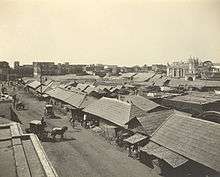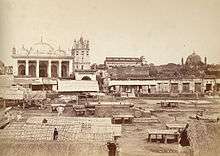Chowk Bazaar
Chawk Bazaar is a well known bazaar in Chowkbazar Thana, Old Dhaka, Bangladesh. It dates back to the Mughal period.


.jpg)
.jpg)
History
Chowk Bazaar was one of the most famous business and social meeting centres of Dhaka in the Mughal period. Even after 400 years it is still as famous as before. It is one of Dhaka's oldest town markets and it formed in the place where other old markets once were. King Maan Singh protested for the country on behalf of Mugal kingdom. In 1602 he transferred the head office in Bawal to the present Central Prison and also the Mughal Durgo, that's how Chowk Bazaar formed.
In 1702, Murshid Kuli Kha named the market "Padosha" or "Badshahi Bazar". From 1733 to 1734, his son-in-law, Murshid Kuli Kha II, renovated the market. It is thought to have started in Munsil times and for Mursid Kuli Kha the market was established.
In the 18th century, Chowk Bazaar was a famous social and business centre. Along with the Historical significance, the geological settlement of this zone also contributed to its massive activities, expansion, population increase, and popularity. The great Buriganga river was just at the South of Chak-Bazaar, which contributed easy water transport and thus made trade more frequent and efficient. Sometimes this Chak-Bazaar was known as Chak-Port. Chak-Bazaar was located in such a way that 10 different other places were connected with Chak-Bazaar by straight roads. However the area was not so good-looking.
From 1823 to 1825, Dhaka community's two men, Dhaka's Magistrate Dos and Walters wanted Chowk Bazaar in the right way and improve the nearby roads condition. For this Dos suggested for the Nawabpur Road to widen as it was linked with Chowk Bazaar. The road was very narrow and filled with cottages but there was no improvement by the end of the 18th century. Dhaka Community did not give permission but Walter got permission later. He removed all illegal markets in Chowk Bazaar and made a 460 ft length, 4 ft high and 1/2 ft thick wall surrounding it. In front of Chowk Bazaar there was Moriom's Canon 'Kaman'. It was in Shoari Ghat before. Not only that he also widen the way from Chowk Bazaar to Islampur.
In 1840, James Taylor said Chowk Bazaar is in the west side of the country and alongside the river. It is a huge square surrounded by markets. Here selling takes place. Various products and materials were used to sold in Chowk bazaar. Fruits, vegetables, toys, sweets and other small products were used to sold and supplied in this Bazaar. The Chowk Bazaar Business centre is situated in a place which was known as " Nakhash". The "Nakhash" is an Arabic word, which is known to be the place where animals and slaves were bought and sold. It was believed that there was a time when slaves were sold, supplied, and bought in an open market and there was low wall and suitable place for driving. In 1869 there was questioning about renovating. In local newspaper they mentioned about renovating but shopkeepers were against it and said there was no need for it.
In 1906, a journal was published by Bradly Bart, it was named as Romance of an Eastern Capital. There Sir Bradly Bart mentioned about the lavish lifestyle of Mughol period. He wrote that " Though Chowk Bazaar has lost its earlier Moghol lavish and extreme expression, but the Chowk Mosque still become crowded by Muslim worshippers. The whole Mosque is decorated by exterior lights and somehow people try to bring the old image and taste of the early Moghol period into the Mosque. According to Bradly's journal, the Chowk Mosque played its role as the main central Mosque. At that time there was no electronic loud speaker system to amplify the sound of Ajaan. The Ajaan was called up with loud voices from the Chowk Mosque. During Jumma the Muslims gather and stand for prayer in front of this Chowk Masque, just like the Eid Jamat.
Within Chowk Bazaar, Islam Kha constructed a Fort during the 17th century, which lasted till 1772. After that the central Jail was established over this Fort. It was believed that sometimes the guilty condemned prisoners were used to hang to death on the centre of the Chowk Bazaar plaza. There was a setup for performing the Prosecution process within the Chowk Bazaar field, by the Central Jail authorities. Raia Bazaar was to be removed and prison was supposed to be placed which would be a problem for people living there. In 1917, Patrick Gaddes said the same. He was told to submit Dhaka Government proposal of Development. He asked for the removal of the prison from Chowk Bazaar, still the same proposal is going on. At the beginning of the 19th century, it was still the same, during Ramadan it is very crowded because of the mogli food available there. From first day of Ramadan people always comes here. Mohoram Akra wrestlers and others showed amazing sword and fighting acts. They used to come from villages and showed this acts all night long but all this seem to have disappeared now.
Nazir Hossain said that before getting marriage, bridegrooms went around Chowk Bazaar. Some went around once, five times seven times etc. All this made Chowk Bazaar filled with fun and celebrations. If they didn't go to give salaam their wedding would seem incomplete. Even now old Dhaka locals go around Chowk Bazaar but this tradition might become extinct in the future.
Several buildings in the bazaar were damaged during a fire in 2019.[1]
Architectural structures
There are many historical structures in Chowk Bazaar which include the Mughal Shahi Mosque, Choto Katra by Shaista Khan and Bara Katra by Mughal prince Shah Shuja.
Present bazaar description
It is a very good place for shopping as variety of goods is available and they are sold at the cheapest rates. The bazaar has spice shops. During Ramadan Chowk Bazaar is famous for its Iftar items which include Moglai and other traditional items.It is a very crowded place and the roads are mostly jam-packed.
Shai Mosque
Chowk Bazaar Shai Mosque was built in 1676. This three domed mosque was made by Shaista Khan. Made on 10 feet high platform, 94 feet length and 80 feet width. It was divided among the shops from the ancient times and it was maintained by the shop rents. The mosque was built according to the rules of Shaista Khan and nearby places. After lot of time of innovation it lost its appeal Dhaka's noble people came to pray here. It was written:
Ameer of Ameers who cleaves to the right majid Shaista did build Gods right I said to the seeker equiring. Its date accomplished we know is God's bidding
References
- "Deadly fire sweeps Dhaka historic district". 21 February 2019. Retrieved 21 February 2019.
- Dhaka Smriti Bismriti'r Nagari by Mumtasir Mamun.Published by Bangla Academy, Dhaka, Bangladesh. ISBN 984-07-3142-4
- "Chawk Bazar, Dhaka". Diary from Bangladesh. Archived from the original on 14 July 2012.
- "Chawk Bazar, the heart of the old city". Dhaka Calling: A Monthly Tourist Guide. Vol. VIII no. 1. October 2009. Archived from the original on 21 November 2013.